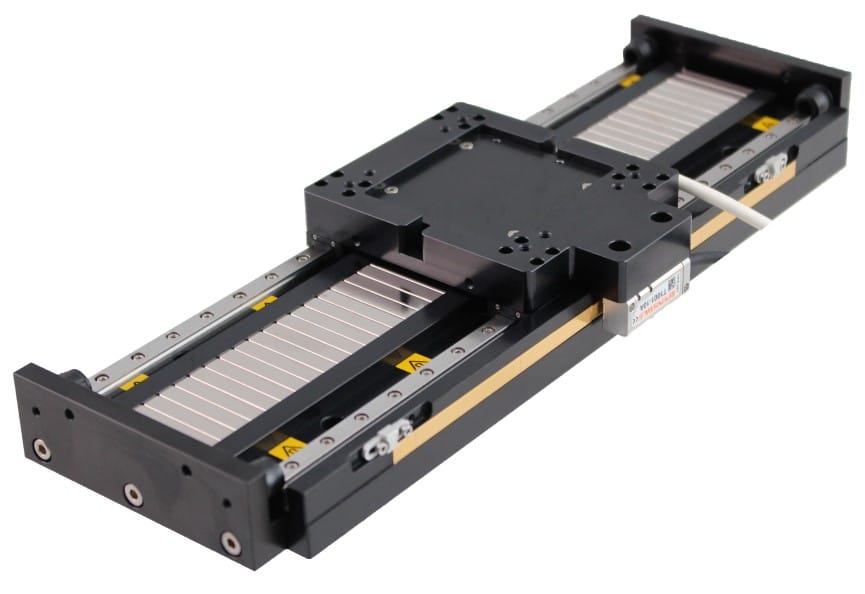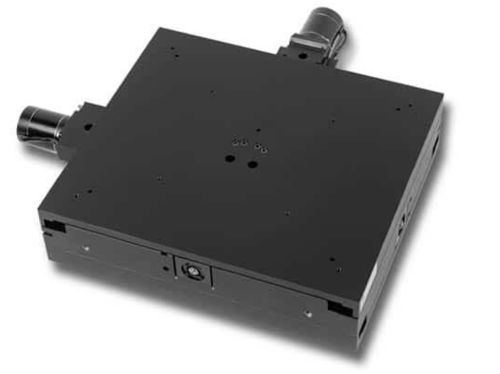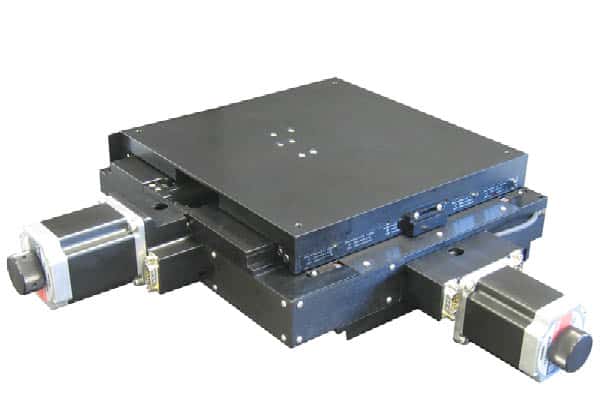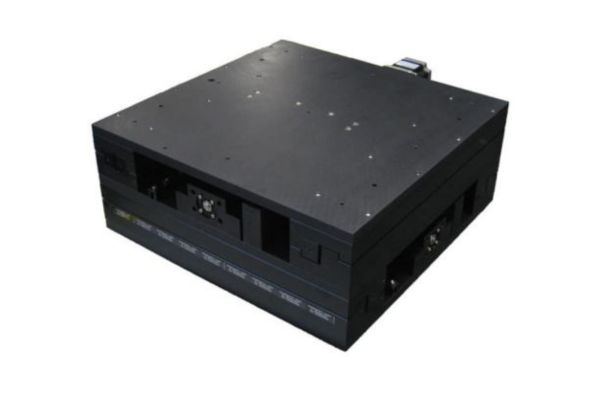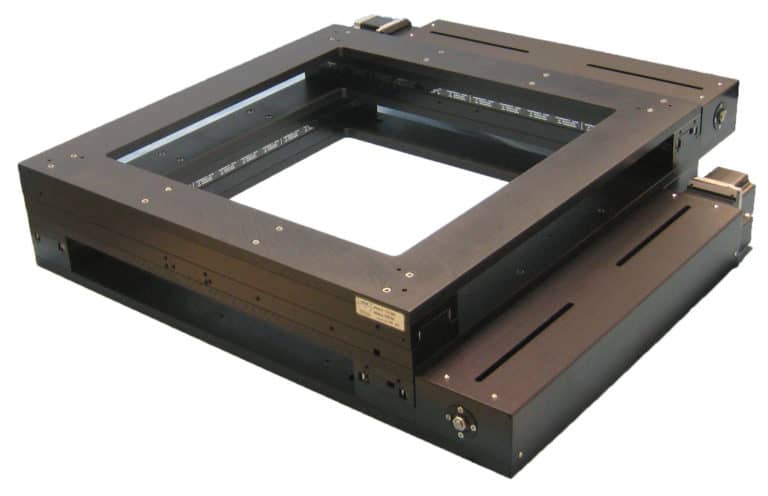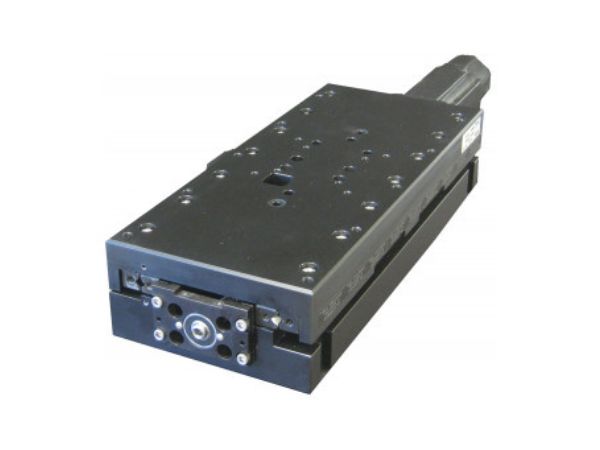Long Travel Linear Stages: 200+ mm
Dover Motion designs and manufactures long travel linear stages, for high-precision motion control in demanding industrial, semiconductor, and life science applications. Featuring our powerful direct drive and linear motor technology, our stages deliver travel lengths from 200 millimeters up to 685 millimeters, with up to 175 kg max payloads and 5 μm accuracy.
In addition to our standard product configurations, Dover Motion offers custom long travel linear stage solutions designed to meet unique payload, speed, and precision requirements. Explore our range of long travel stages below to find the stage that fits your application.
Long Travel Linear Stage Products
The SmartStage Shuttle is a long travel linear stage, which provides linear motor precision and throughput for XY stage applications.
| wdt_ID | Travel | 200 - 500 mm |
|---|---|---|
| 1 | Accuracy | 5 μm |
| 2 | Repeatability | 1.2 μm |
| 3 | Payload | 10 kg |
The MMS™ – Miniature Long Travel Linear Stage ideal for imaging applications where a long travel load/unload axis is required.
| wdt_ID | Travel | 200 - 400 mm |
|---|---|---|
| 1 | Accuracy | < 15 μm |
| 2 | Repeatability | 2 μm |
| 3 | Payload | 12 kg |
The XYR™ series XY positioning stage uses a lead screw for motion. The monolithic integrated XY center makes the stage stiff and compact.
| wdt_ID | Travel | 50 - 300 mm |
|---|---|---|
| 1 | Accuracy | 15 μm |
| 2 | Repeatability | < ± 3 μm |
| 3 | Payload | 175 kg |
The XYRB™ series precision XY stage is similar to the XYR™, but incorporates a ball screw for more precise and repeatable positioning. The encoder option improves accuracy.
| wdt_ID | Travel | 50 - 300 mm |
|---|---|---|
| 1 | Accuracy | 8 μm TIR |
| 2 | Repeatability | < ± 1 μm |
| 3 | Payload | 175 kg |
The XYL™ series long travel linear stage has the largest table size, longer travels, and larger bearings for a stiffer platform that can handle larger payloads.
| wdt_ID | Travel | 300 - 685 mm |
|---|---|---|
| 1 | Accuracy | 35 μm TIR |
| 2 | Repeatability | < ± 3 μm |
| 3 | Payload | 175 kg |
The OFL™ series motorized XY stage provides increased travel and load bearing capacity in an open frame XY configuration.
| wdt_ID | Travel | 200 - 635 mm |
|---|---|---|
| 1 | Accuracy | 80 μm TIR |
| 2 | Repeatability | < ± 3 μm |
| 3 | Payload | 80 kg |
The FM™ series is a ball screw linear stage with a stiffer table and larger crossed roller bearings.
| wdt_ID | Travel | 100 - 350 mm |
|---|---|---|
| 1 | Accuracy | 5 μm TIR |
| 2 | Repeatability | < ± 1.5 μm |
| 3 | Payload | 115 kg |
The Airglide™ air bearing stage design uses precision stiff air bearings for large payloads.
| wdt_ID | Travel | 150 - 400 mm |
|---|---|---|
| 1 | Accuracy | 4 μm TIR |
| 2 | Repeatability | < ± 0.4 μm |
| 3 | Payload | 40 kg |
FAQ
A long travel linear stage is a precision mechanical device engineered to translate a payload in a straight line over extended distances—typically greater than 200 mm and up to one meter or more—while maintaining high accuracy, repeatability, and stiffness.
Long travel linear stages combine extended motion range with sub-micron or nanometer-level precision, making them fundamental to advanced automation, metrology, and photonics systems.
These stages integrate high-stiffness bearing systems (such as crossed-roller, recirculating ball, or air bearings) with precision drive mechanisms—including ball screws, linear motors, or belt drives—to achieve smooth, repeatable motion under varying loads. Linear encoders or rotary feedback devices provide closed-loop control for accurate positioning and trajectory tracking.
Long travel linear stages are available in both motorized and manual configurations and can be assembled into multi-axis XY or XYZ systems for complex positioning or scanning applications.
Long travel linear stages are used in applications and industries that require accurate, repeatable movement over extended travel distances. These stages are commonly used in semiconductor inspection, metrology, life sciences, photonics, laser processing, and advanced manufacturing:
- In semiconductor and electronics manufacturing, long travel stages enable precise wafer and substrate positioning during inspection and lithography alignment.
- In optical metrology, they provide stable, vibration-free motion for scanning interferometers and profilometers.
- Within the life science and microscopy industry, they support automated slide scanning, multi-well plate imaging, and long-range sample translation.
- In photonics and laser processing, long travel linear stages align optical elements, fibers, and laser beams with sub-micron accuracy across large travel ranges.
- They are also integrated into industrial automation and precision assembly systems where both long-range motion and fine positional control are required — such as in robotics, additive manufacturing, and component inspection.
By combining extended travel, high stiffness, and encoder feedback for precise position control, long travel linear stages allow engineers to bridge the gap between coarse positioning and high-precision motion, making them vital components of motion systems for modern high-tech instrumentation and production environments.
Travel options for a long travel linear stage commonly exceed 200 mm and can reach 600 mm or more, depending on the specific model and application.
Long travel linear stages are divided into two types based on the actuation method:
- Motorized: Driven by motors, such as DC servo or stepper motors, for automated and precise control.
- Manual: Operated by hand, often using a dial or screw mechanism.
Bearing architecture is the primary determinant of a linear stage’s geometric accuracy, stiffness, dynamic behavior, and environmental robustness. It governs straightness/flatness, parasitic pitch/yaw/roll, servo tuning limits, life, and maintenance. Below is a comparative view and the engineering implications of each bearing type:.
- Crossed-roller bearings (CRB):
- Geometry & stiffness: Line contact with orthogonally crossed rollers delivers very high in-plane and moment stiffness (Mx, My, Mz), low compliance, and excellent geometric errors (straightness, flatness, pitch, yaw, roll).
- Friction & motion quality: Low, smooth rolling friction with minimal stiction/hysteresis, enabling nanometer-scale interpolation and tight velocity regulation.
- Load capacity & life: Higher static/dynamic load for a given envelope than ball bearings; predictable wear when properly preloaded and lubricated.
- Speed/duty: Good for moderate–high duty; generally lower top speed than profile-rail recirculating bearings due to roller dynamics.
- Use when: You need high precision over long travel, tight pitch/yaw control, and high moment capacity (e.g., metrology, photonics alignment, semiconductor inspection).
- Recirculating ball bearings (profile rail guides)
- Geometry & stiffness: Point contact; lower stiffness and higher compliance than crossed roller bearings at a similar size. Straightness and parasitic angular errors are adequate for general precision but not metrology-grade without error mapping.
- Friction & dynamics: Balls recirculate through return paths → waviness and micro-velocity ripple at low speeds; can limit constant-velocity scanning and servo bandwidth.
- Speed/duty: Higher allowable speed and long travel lengths; robust for industrial duty cycles.
- Cost & maintenance: Lower cost, widely available; periodic lubrication required.
- Use when: You need general precision, long travel, high throughput, and cost efficiency (automation, assembly, material handling with precision requirements applications).
- Air bearings (aerostatic/air-slide)
- Geometry & stiffness: Non-contact film yields near-zero friction, no stick-slip, and ultra-low geometric error; superb straightness and angular fidelity.
- Dynamics: Enable very smooth scanning and high servo bandwidth; excellent for nanometer-level positioning and constant velocity.
- Constraints: Requires clean, dry air, filtration, supply regulation, and a clean environment; lower load capacity per footprint vs crossed roller bearings; crash risk if air is lost.
- Use when: Highest precision and velocity smoothness are mandatory (interferometry, wafer and mask metrology, ultra-precision machining applications).
Selecting the right long travel linear stage requires evaluating multiple interdependent specifications that define precision, load capacity, throughput, and system integration options. Each parameter directly affects positioning accuracy, dynamic behavior, and long-term reliability in high-performance motion systems. Let’s review all key specifications to be considered below:
- Travel Range: It defines the maximum linear displacement of the stage and should accommodate both operational motion and alignment margins. Long travel stages typically span 200 mm to over 600 mm, with some designs exceeding 1 meter. Engineers should consider Abbe offsets, cable management, and potential thermal expansion over extended motion distances.
- Bearing Type and Straightness: The bearing architecture (crossed-roller, recirculating ball, or air bearing) defines geometric performance—specifically straightness, flatness, and parasitic pitch/yaw/roll. Crossed-roller bearings offer superior stiffness and repeatability for precision scanning; air bearings provide virtually frictionless motion for nanometer-scale uniformity; ball bearings meet general precision automation requirements at a lower cost.
- Load Capacity and Stiffness: Define both axial load (Fx, Fy, Fz) and moment capacity (Mx, My, Mz). High moment stiffness is essential when payloads are offset from the stage center or mounted in vertical configurations. Proper load analysis ensures minimal deflection and consistent dynamic response during acceleration and deceleration.
- Drive Mechanism: The drive type determines motion smoothness, thrust, and achievable velocity. The choice depends on throughput needs, duty cycle, and required trajectory fidelity:
- Ball screw drives – high thrust, low backlash, precise positioning, moderate speed.
- Linear motor drives – direct-drive architecture enabling frictionless, high-speed motion and zero backlash.
- Stepper or servo motor systems – balance torque, resolution, and closed-loop control flexibility.
- Feedback and Position Accuracy: High-precision applications rely on direct linear encoders for sub-micron to nanometer-level feedback. Encoder selection (optical, magnetic, interferometric) defines resolution, repeatability, and bi-directional accuracy. Closed-loop systems with integrated servo tuning maintain consistent accuracy across temperature changes and varying loads.
- Resolution and Repeatability
- Resolution: The smallest incremental motion the system can command and verify—typically driven by encoder counts per millimeter or interferometric feedback.
- Repeatability: The ability to return to the same commanded position consistently—critical for scanning, alignment, and metrology.
- Speed and Acceleration: Long travel stages must balance velocity and stability. High-throughput inspection systems may demand hundreds of mm/s with rapid settle times. Precision alignment systems prioritize smooth, low-velocity control for sub-micron positioning. Acceleration profiles should match the payload’s mass and stiffness to minimize vibration and overshoot.
- Control and Interface: Motorized linear stages can be controlled through digital interfaces such as EtherCAT, RS-232, or USB, allowing integration with vision systems, motion controllers, and automation software. Manual stages use micrometer heads or fine-pitch screws for positioning. For multi-axis systems, synchronized control ensures coordinated XY or XYZ trajectories and repeatable compound motions.
- Environmental and Mechanical Considerations: Operating environment influences component selection:
- Vacuum-compatible materials for semiconductor or photonics use.
- Cleanroom-rated lubrication for life sciences and precision optics.
- Dust seals and covers for industrial manufacturing.
- Thermal behavior, cable routing, and mounting flatness also impact stage performance and lifetime stability.
Summary:
When designing a motion system, engineers should evaluate the entire stage architecture—bearings, drive, encoder feedback, and control interface—as an integrated system. The right balance between travel range, precision, load capacity, and throughput ensures the stage meets both performance and reliability requirements in demanding applications such as semiconductor inspection, metrology, life sciences, and photonics manufacturing.



